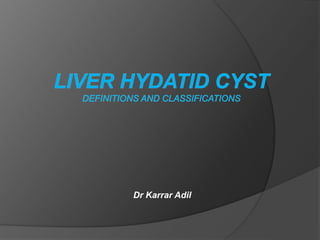
HYDATID CYST OF LIVER.pptx
- 2. Introduction : Human echinococcosis is a zoonotic disease that is caused by parasites, namely tapeworms of the genus Echinococcus. The two most important forms in humans are cystic echinococcosis (hydatidosis) and alveolar echinococcosis. Humans are infected through ingestion of parasite eggs in contaminated food, water or soil, or after direct contact with animal hosts.
- 3. A number of herbivorous animals act as intermediate hosts of Echinococcus. They become infected by ingesting the parasite eggs in contaminated food and water, and the parasite then develops into larval stages in the viscera. Carnivores act as definitive hosts for the parasite, and harbour the mature tapeworm in their intestine. The definitive hosts are infected through the consumption of viscera of intermediate hosts that contain the parasite larvae. Humans act as accidental intermediate hosts in the sense that they acquire infection in the same way as other intermediate hosts, but are not involved in transmitting the infection to the definitive host.
- 4. The genotype causing the great majority of cystic echinococcosis infections in humans is principally maintained in a dog–sheep–dog cycle. Alveolar echinococcosis usually occurs in a wildlife cycle between foxes or other carnivores with small mammals (mostly rodents) acting as intermediate hosts. Domesticated dogs and cats can also act as definitive hosts. Liver is commonly involved (65%); lungs (25%); muscles (5%); bones(3%); rarely kidneys, brain, spleen.
- 5. Hydatid cyst structure : It has got three layers : 1- the pericyst (Adventitia) (pseudocyst) : consists almost entirely of host cells. is an inseparable fibrous tissue due to reaction of the liver to the parasite. 2- Laminated membrane (ectocyst) : formed by the parasite itself. is elastic white covering, easily separable from the adventitia. 3- Germinal epithelium (endocyst) : is the only living part, lining the cyst. secretes hydatid fluid, brood capsules with scolices. Once brood capsules disintegrate, it grows into daughter cysts.
- 7. Echinococcosis Classification : • Cystic echinococcosis (Classic Hydatid cyst): caused by Echinococcus granulosus. most common form. • Alveolar echinococcosis : also known as alveolar hydatid disease and small fox tapeworm. caused by Echinococcus multilocularis. The second most common form. • Polycystic echinococcosis : also known as human polycystic hydatid disease. caused by Echinococcus vogeli.
- 8. Gharbi ultrasound based classification of liver hydatid cysts (1981) : • Type 1 : Pure fluid collection. • Type 2 : Fluid collection with split wall (Membrane separation). • Type 3 : Fluid collection with septa. • Type 4 : Heterogeneous appearance (hypo + hyperechoic). • Type 5 : Reflecting thick walls (completely calcified).
- 10. WHO classification of hepatic hydatid cyst : is used to assess the stage of hepatic hydatid cysts on ultrasound and is useful in deciding the appropriate management depending on the stage of the cyst.
- 11. This classification was proposed by the WHO in 2001 and remains the most widely used classification for hepatic hydatid cysts. Cyst stages as described by the classification are defined by their observable physical characteristics and account for changes in parasite activity/viability.
- 12. Classification : 1) Type - CL : Active. Unilocular. no cyst wall. early stage. not fertile.
- 13. 2) Type - CE 1 : Active. cyst wall present. hydatid sand present. Fertile.
- 14. 3) Type - CE 2 : Active. multivesicular rosette like cyst wall. Fertile.
- 15. 4) Type- CE 3 : Transitional. detaching laminated membrane. water-lily sign. beginning of degeneration.
- 16. 5) Type - CE 4 : Inactive. degenerative contents. no daughter cysts. not fertile.
- 17. 6) Type - CE 5 : Inactive. thick calcified wall. not fertile.
- 18. WHO-IWGE USG classification : IWGE : informal Working Group on Echinococcosis • Group 1 : Active-cyst >2 cm; fertile. • Group 2 : Transitional group - may contain viable scolices. • Group 3 : Inactive - degenerated, calcified, non viable cyst.
- 19. Thank you …